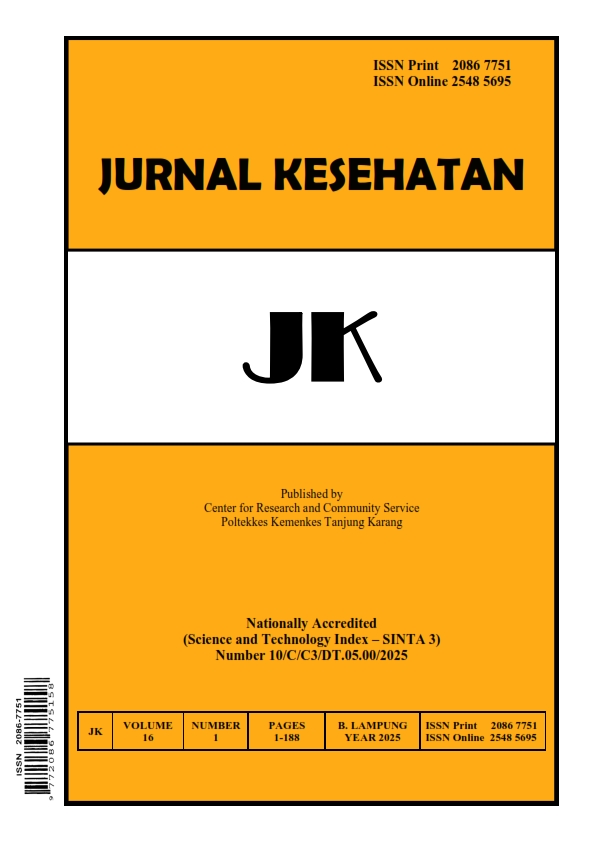Implementation of Anti-Stroke Exercises to Address Stroke Prevention in Villages
DOI:
https://doi.org/10.26630/jk.v16i1.4720Keywords:
Community-based prevention, Early detection, Public healthAbstract
Stroke remains a leading cause of disability and death, particularly in village areas where access to health education and preventive services is limited. While physical activity is known to reduce stroke risk, structured, community-based prevention programs are rarely implemented or studied in village settings. This study evaluates the implementation of anti-stroke exercises for stroke prevention in a village in Magelang, Central Java. A qualitative descriptive approach was used. Data were collected through focus group discussions and semi-structured interviews with village residents, community health workers, and local leaders in three village villages where the anti-stroke exercise program had been introduced. Thematic analysis was used to interpret the data. Participants reported increased awareness of stroke risk factors and the importance of physical activity. The exercise sessions were generally well-received and promoted social interaction among participants. Three key points for implementing anti-stroke exercises in rural areas aimed at preventing stroke were identified: early detection, education, and community participation. The program contributed to stroke prevention efforts by raising awareness and encouraging healthier lifestyles in village communities. Community engagement and leadership played crucial roles in the success of implementation. To strengthen the program, ongoing facilitator training, integration into broader public health strategies, and government support are needed. Regular monitoring and community feedback can help sustain and scale the initiative effectively.
References
Arimbi, A., Usman, A., Rhesa, M., Fahrizal, F., & Wahid, W. M. (2023). Penyuluhan deteksi dini stroke dan senam anti-stroke pada lansia. J-ABDI: Jurnal Pengabdian kepada Masyarakat, 3(6), 1143-1148. https://doi.org/10.53625/jabdi.v3i6.6654
Darmojo, R., Setianto, B., Sutedjo, R., Kusmana, D., Andradi, S., & Supari, F. (1990). A study of baseline risk factors for coronary heart disease: Results of population screening in a developing country. Revue d'Épidémiologie et de Santé Publique, 38(5-6), 487-491.
Dinas Kependudukan dan Pencatatan Sipil Kabupaten Magelang. (2022). Data konsolidasi bersih semester I 2022: Jumlah penduduk keseluruhan Kabupaten Magelang. Magelang.
Erawati, E., Ridwan, M., & Talib, S. T. R. (2023). Application of anti-stroke exercises on stroke prevention behavior among risk group of stroke in the community. International Conference on Handling Non-Communicable Diseases (pp. 491-495).
Ghozy, S., Zayan, A. H., El-Qushayri, A. E., Parker, K. E., Varney, J., Kallmes, K. M., & GBD (2019). Stroke Collaborators. Global, regional, and national burden of stroke and its risk factors, 1990-2019: A systematic analysis for the Global Burden of Disease Study. The Lancet Neurology, 20, 795-820.
Melati, M., Utomo, W., & Agrina, A. (2021). Pengaruh senam anti-stroke terhadap tekanan darah pada penderita hipertensi. Jurnal Ners Indonesia, 11(2), 206-214. https://doi.org/10.31258/jni.11.2.206-214
Ministry of Health Republic Indonesia. (2018). Profil Kesehatan Indonesia Tahun 2018. Jakarta. https://pusdatin.kemkes.go.id/resources/download/pusdatin/profil-kesehatan-indonesia/Profil-Kesehatan-Indonesia-2018.pdf
Ministry of Health Republic of Indonesia. (2019). Pedoman pelaksanaan CERDIK dalam upaya pengendalian penyakit tidak menular. Jakarta. https://promkes.kemkes.go.id/resources/download/pedoman/ptm/Pedoman-Pelaksanaan-CERDIK.pdf
Ministry of Health Republic of Indonesia. (2021). Pedoman pelaksanaan posbindu penyakit tidak menular. Jakarta. https://p2ptm.kemkes.go.id/folder/view/01/structure-p2ptm/pedoman-posbindu-ptm.html
Ministry of Health Republic Indonesia. (2023). Survei Kesehatan Indonesia (SKI) 2023. Jakarta. https://www.badankebijakan.kemkes.go.id/hasil-ski-2023
Ministry of Health Republic Indonesia. (2023). Undang-Undang Republik Indonesia Nomor 17 Tahun 2023 tentang Kesehatan. (2023), Lembaran Negara Republik Indonesia Tahun 2023 Nomor 94. Jakarta.
Nainggolan, S. S., & Utama, Y. A. (2022). Pelaksanaan senam anti-stroke pada lansia di Posyandu Lansia RT 12 Kelurahan Sukodadi Kecamatan Sukarame Palembang. Jurnal Abdimas Musi Charitas (JAMC), 6(1), 14-20. https://doi.org/10.32524/jamc.v6i1.339
Nussbaum, M. C. (2011). Creating capabilities. Harvard University Press. https://doi.org/10.4159/harvard.9780674061200
Pemerintah Kabupaten Magelang. (2022). Satu data Kabupaten Magelang: Data sektoral Dinas Kesehatan Kabupaten Magelang. Magelang. https://pusaka.magelangkab.go.id/kesehatan/dinkes/data_sektoral
Schuck, P. H. (2002). Affirmative action: Past, present, and future. Yale Law & Policy Review, 20(1), 1-96. https://www.jstor.org/stable/41308517
Ward, Z. J., & Goldie, S. J. (2024). Global Burden of Disease Study 2021 estimates: Implications for health policy and research. The Lancet, 403(10440), 1958-1959.
https://doi.org/10.1016/S0140-6736(24)00812-2
World Health Organization. (2020). Non-communicable diseases country profiles 2020. World Health Organization. https://www.who.int/publications/i/item/9789240000317
Venketasubramanian, N., Yudiarto, F. L., & Tugasworo, D. (2022). Stroke burden and stroke services in Indonesia. Cerebrovascular Diseases Extra, 12(1), 53-57. https://doi.org/10.1159/000524161
Downloads
Published
Issue
Section
License
Copyright (c) 2025 Erna Erawati, Moh. Ridwan, Hermani Triredjeki, Susi Tentrem Roestyati Talib, Tulus Puji Hastuti

This work is licensed under a Creative Commons Attribution-ShareAlike 4.0 International License.
Authors who publish in this journal agree to the following terms:
- Authors retain copyright and grant the journal right of first publication with the work simultaneously licensed under a Creative Commons Attribution License (CC BY-SA 4.0) that allows others to share the work with an acknowledgment of the work's authorship and initial publication in this journal.
- Authors can enter into separate, additional contractual arrangements for the non-exclusive distribution of the journal's published version of the work (e.g., post it to an institutional repository or publish it in a book), with an acknowledgment of its initial publication in this journal.
- Authors are permitted and encouraged to post their work online (e.g., in institutional repositories or on their website) prior to and during the submission process, as this can lead to productive exchanges and earlier and greater citations of published work.












